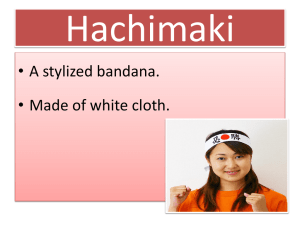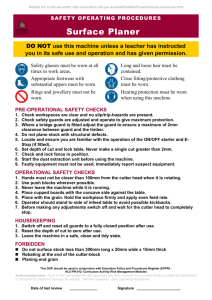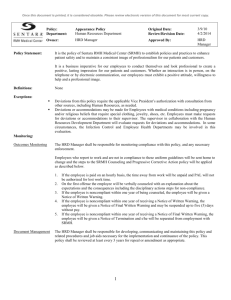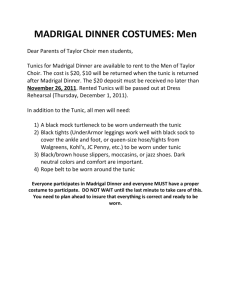The Sea Cadet Uniform
advertisement
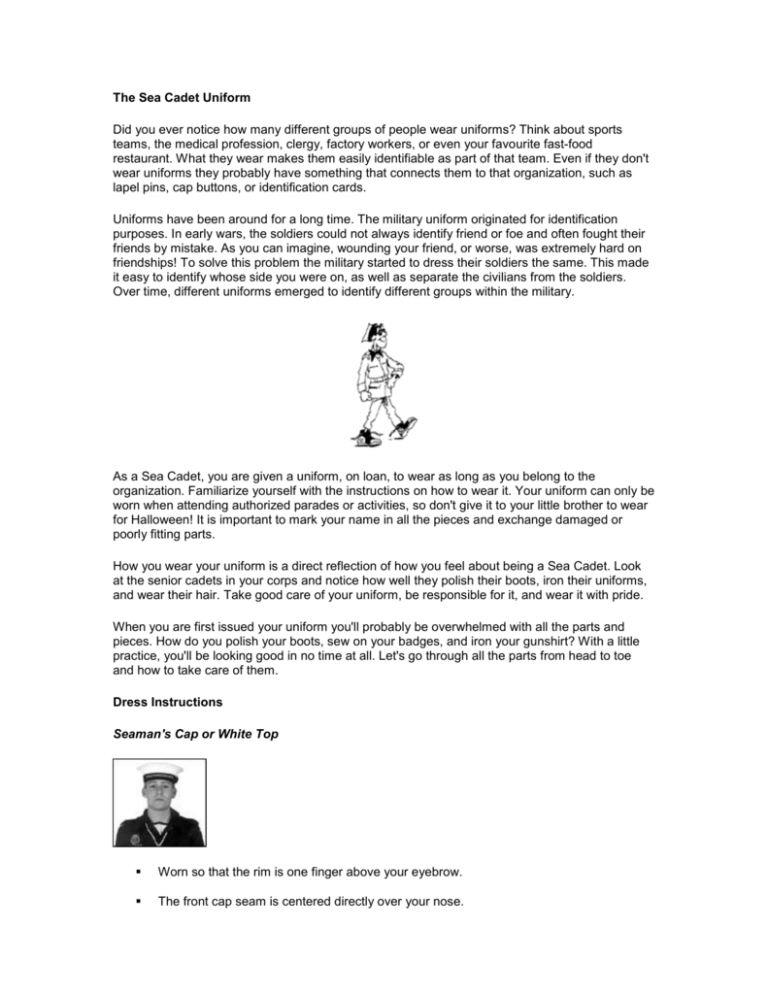
The Sea Cadet Uniform Did you ever notice how many different groups of people wear uniforms? Think about sports teams, the medical profession, clergy, factory workers, or even your favourite fast-food restaurant. What they wear makes them easily identifiable as part of that team. Even if they don't wear uniforms they probably have something that connects them to that organization, such as lapel pins, cap buttons, or identification cards. Uniforms have been around for a long time. The military uniform originated for identification purposes. In early wars, the soldiers could not always identify friend or foe and often fought their friends by mistake. As you can imagine, wounding your friend, or worse, was extremely hard on friendships! To solve this problem the military started to dress their soldiers the same. This made it easy to identify whose side you were on, as well as separate the civilians from the soldiers. Over time, different uniforms emerged to identify different groups within the military. As a Sea Cadet, you are given a uniform, on loan, to wear as long as you belong to the organization. Familiarize yourself with the instructions on how to wear it. Your uniform can only be worn when attending authorized parades or activities, so don't give it to your little brother to wear for Halloween! It is important to mark your name in all the pieces and exchange damaged or poorly fitting parts. How you wear your uniform is a direct reflection of how you feel about being a Sea Cadet. Look at the senior cadets in your corps and notice how well they polish their boots, iron their uniforms, and wear their hair. Take good care of your uniform, be responsible for it, and wear it with pride. When you are first issued your uniform you'll probably be overwhelmed with all the parts and pieces. How do you polish your boots, sew on your badges, and iron your gunshirt? With a little practice, you'll be looking good in no time at all. Let's go through all the parts from head to toe and how to take care of them. Dress Instructions Seaman's Cap or White Top Worn so that the rim is one finger above your eyebrow. The front cap seam is centered directly over your nose. Your chinstay is to be sewn inside your cap at the length that permits the stay to fit under your chin. You do not wear your chinstay unless you are told to. Hand wash your cap regularly in cold water and detergent, using an old toothbrush to scrub the dirt off. Cap tallies with "Royal Canadian Sea Cadets" should be centered so that the front cap seam is between the "I" and "A" of the word "Canadian". Tie your cap tally with a neat bow, not more than 7.5 cm and not less than 5 cm across. The ends are of equal length. Center your bow over the left ear vents. Cap tallies with corps names shall be worn the same way, except centered accordingly. Turtlenecks May be worn during the winter with or without the tunic, but your tunic must be worn when proceeding to and from the corps. Sleeves shall not be rolled. Gunshirt May be worn during the summer with or without the tunic, but your tunic must be worn when proceeding to and from the corps, or any official cadet activity. Sleeves are pressed with a crease along the upper edge of each sleeve. Iron a vertical crease down the front of your gunshirt. Use starch for extra crispness. Tunic Sleeves shall be roll-pressed with no creases. When your tunic is worn, it shall be fully buttoned, except for the first button down from the top. Ensure all your pocket buttons are done up. Do not fill your pockets with items so that they bulge out. Be sure your belt is even, with no twists. Use a pressing cloth (thin towel, or pillow case) when ironing, to prevent shininess. Lanyard Worn under the collar of your tunic. The knot is at the level of your first fastened button. Tuck the end of your lanyard into the inner corner of left breast pocket with the slack or bight hanging 8 cm below the level of the top of pocket. Do you know why World War I pilots, including Royal Naval Air Service (RNAS), wore silk scarves around their necks? Because their airplanes didn't have rear view mirrors they had to constantly turn their heads back and forth to look for enemy planes. This caused chafing so they donned silk scarves to prevent irritation. Trousers Male trousers are worn with a black belt. Pressed so as to have creases down the center of each leg. Wet your pants (with a spray bottle filled with water) when ironing to make sharp creases, and don't forget to use a pressing cloth to prevent shininess. A pressing cloth can be a towel or piece of cotton material laid overtop of your pants while you iron. Parkas 3-in-1 design. Black, drawstring waist with fleece lining. Can be worn on mandatory support weekends. To be worn with rank slip-ons and Sea Cadet badge Gloves Worn with your topcoat or parka when the weather is cold. Toque Worn so that the rim of the toque is one finger above the eye-brow. Wool or acrylic. The insignia is centered directly over your nose. Worn only with the topcoat or parka. Did you know the coldest spot recorded in Canada is at Snag, Yukon? On February 3, 1947 the temperature was -63 degrees C (-81 degrees F). Don't forget to wear your toque! Socks Grey wool socks. If you are allergic to wool, white sports socks can be worn under your grey wool socks, or a suitable replacement used. Boots Laced horizontally from side to side. There are time-honored methods to bringing your boots up to the shiny standard you see on other boots. It takes time and patience, but hard work will bring great results. Try the following: Remove dust and dirt from boot with a soft damp cloth. Use an old toothbrush to remove dirt from catwalks. Use a toothbrush, with polish, to blacken the catwalks. Apply a moderate amount of polish to the area of the boot you will polish first. Use a polishing cloth or other soft cloth wrapped around your index finger and dampened with cool water. You should work on one section at a time. Apply the polish in a circular motion. Start with larger circles to cover the area with polish. Use smaller circles as the polish works into the boot. Continue with the circular motion until you can no longer see the circles formed by the polish. You will have to continue applying coats of polish in this way until the boots have a high gloss. Be patient, good boots take time. Webbing Worn by guards, gun crews, band members, quartermasters and members of gangway staff while on duty, Chief Petty Officers, duty yeomen, duty buglers, members of side parties, and drill teams. Webbing consists of white web or plastic belt and white web gaiters which go around your ankles. White belts shall not be worn without gaiters. Gaiters shall be worn with the scalloped edges down, buckles to the outside, tab ends to the back and tucked into retaining loops. Categories of Dress Ceremonial Orders of Dress Service Orders of Dress Routine Training Orders of Dress Sea Training Orders of Dress Badges Will be sewn on the cadet tunic neatly, using a thread which blends in with the material. Rank badges (Able Seaman to Petty Officer Second Class) are worn on the upper left sleeve, centered midway between the shoulder seam and the point of the elbow. Rank Badges (Petty Officer First Class to Chief Petty Officer First Class) are worn on the lower left sleeve, centered midway between the bottom of the cuff and the point of elbow. Do you know what the latin saying "A Mari Usque Ad Mare" found on the Chief Petty Officer First Class rank badge means? It translates to "From Sea to Sea". Qualification and appointment badges are worn on the upper right sleeve centered midway between the shoulder seam and the point of the elbow. Qualification Badges are awarded upon successful completion of summer training courses and Appointment Badges are awarded at the corps to indicate which job you have. Qualification Badges Appointment Badges Proficiency Badges Proficiency badges are worn on the lower right sleeve, directly above the upper seam of the cuff. They are awarded for attaining levels outside of summer training. With the exception of the first aid badge, only one proficiency badge may be worn. If the first aid badge is worn it shall be placed in the superior position 6 mm above the proficiency badge. You cannot wear a proficiency badge and qualification badge for the same thing together. A pip badge is worn below the proficiency badge to indicate the level you have attained. Duke of Edinburgh Award Badges shall be worn centered on the left breast pocket of the jacket. Staff cadet badge shall be worn on the upper right sleeve, 6 mm below the qualification badge, both badges being centered midway between the shoulder seam and the point of the elbow. Service year badges are worn on the lower left sleeve, directly above the upper seam of the cuff. They represent the number of years completed in Cadets. They are also used to indicate qualification levels obtained when worn with Trade Group badges and Proficiency badges. Corps crest badges are worn centered above the right breast pocket of the jacket, 3cm above it. If you are wearing a name tag, the name tag fits in the space between the tops of the pocket and the corps crest. The Royal Canadian Sea Cadet Badge is worn on each shoulder of the tunic with the upper edge of the badge as close as possible to the shoulder seam. Corps Title Badge is worn immediately below and in contact with the Royal Canadian Sea Cadet Badge. Royal Canadian Sea Cadet / Corps Title Badges Medals are worn centered above the right breast pocket of the tunic, touching the top of the pocket. In addition to all these instructions, there are also rules regarding jewellery (yes, you can wear some!), and hair (yes, you can have some!). All cadets are allowed to wear a wristwatch, a Medical Alert bracelet, and a maximum of two rings. Necklaces will not be worn in uniform. Female cadets can also wear a single pair of small and plain gold, silver, pearl or clear diamond stud earrings, centered in each earlobe. Other piercings (face, tongue, lip, etc.) are not acceptable. If you are a male cadet, your hair must meet this standard: Neatly groomed. Taper-trimmed at the back, sides, and above the ears. Not more than 15 cm in length (when you remove your headdress, it cannot fall below the top of your eyebrows). Not greater than 4 cm in bulk at the top of the head. Styled so that it doesn't present a bizarre or exaggerated appearance (including color). Kept free from the neck to a distance of 2.5 cm above your tunic collar. Sideburns, moustaches and beards can be worn, but must meet the Sea Cadet dress regulations. If you are a female cadet, you must meet this standard: Hair must be neatly groomed and not extend below the bottom collar of your tunic. Exaggerated, bizarre, or unusual hair colors are not permitted. Make-up worn must be limited. No coloured nail polish. It probably seems like there are a lot of rules to follow when wearing your uniform, but it is important that everyone strives to achieve the set standard. When you are in uniform, and in the public eye, people notice how you behave. Conduct such as chewing gum, slouching, smoking on the street and walking hand in hand is forbidden. You should wear your uniform with pride and always be on your best behaviour. You are representing the Sea Cadet organization and that means giving the best impression that you possibly can.
